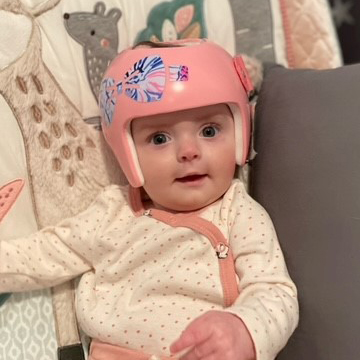The Facts About Plagiocephaly and Torticollis

In honor of National Plagiocephaly & Torticollis Awareness Day on March 20th, we are revisiting what these conditions are and options to prevent and treat them.
Understanding Torticollis and Plagiocephaly
Torticollis is the third most common congenital musculoskeletal condition in newborns.1 It occurs when the muscles in a baby’s neck become stiff or tight, causing the baby’s head to tilt to one side and limiting range of motion. Often, the presence of neck and facial asymmetry is visible at birth or the first week after birth. Torticollis may result from placement in utero or during the birth process, or it may also appear when a baby’s head stays in one position for long periods of time.
Plagiocephaly, also known as “flat head syndrome”, is when a baby develops a flattening on the back or side of the head. While no child (or adult) has a perfectly symmetrical head, there are ranges of normal development. The majority of cranial asymmetries will correct on their own during the first weeks of life. However, a head shape that is not getting better, or may be getting worse, should be evaluated. Similar to torticollis, this condition may appear when a baby’s head stays in one position for long periods of time.
Ask the Expert: Torticollis and Plagiocephaly
We sat down with one of the nation’s leading cranial specialists Katie Toth, CPO, to answer some of the most common questions about torticollis and plagiocephaly.

Tips to Help Prevent or Lessen Symptoms of Torticollis and Plagiocephaly
- Change your baby’s sleeping position. Position your baby on their back and consider placing your baby’s head to sleep in one direction on even days and the opposite direction on odd days.
- Provide your baby with plenty of tummy time when awake. This helps build an infant’s neck, shoulder, and core muscles.
- Move your baby’s mobile to different ends of the crib to encourage looking in different directions.
- Lessen the time your baby spends in swings and carriers, and avoid leaving your baby in one position for long periods of time.
Treating Torticollis and Plagiocephaly
Torticollis is treated by a physical therapist and is best treated as early as possible to resolve the muscular imbalance. Your physical therapist will set up a treatment plan for you and will also monitor for signs of plagiocephaly. Depending on severity, plagiocephaly is treated with tummy time and repositioning, or a cranial remolding orthosis.
Babies who are prescribed a cranial remolding orthosis, also known as a cranial helmet or cranial band, are often required to wear the device for 3-6 months, depending on the severity at the beginning of treatment and baby’s age. It works by gently preventing excessive growth in the direction that is most prominent, while leaving open spaces for the flattened areas of the baby’s head to grow, forming a rounder, more even/symmetric shape.
Why Ava Wears a Helmet
At just 1-month old, Leneé Vet noticed a flat spot on the back of baby Ava’s head. Shortly thereafter, she was diagnosed with plagiocephaly and torticollis. With the help of a cranial helmet and her care team, Ava’s head is gradually growing into a more symmetrical shape.

Wearing & Caring for Your Baby’s Cranial Helmet
If your baby has already been diagnosed with plagiocephaly and/or torticollis and is being treated with a cranial remolding orthosis, watch this video to learn how to apply, remove, care for, and clean the helmet. You’ll also learn more about what to expect during the treatment journey, including the wearing schedule.
Request a Free Evaluation
With over 200 specialists at more than 260 locations nationwide, Hanger Clinic’s network of Cranial Asymmetry Remolding Experts (CARE Network) helps ensure patients and families receive access to unparalleled care and expertise.
Latest Updates
Subscribe to stay up-to-date on our latest posts.


